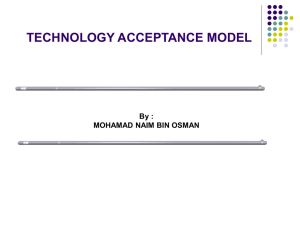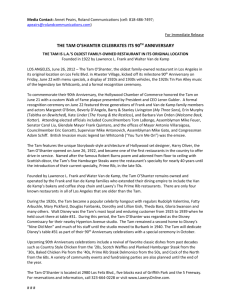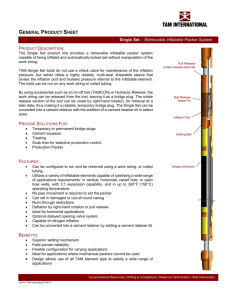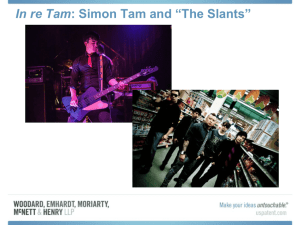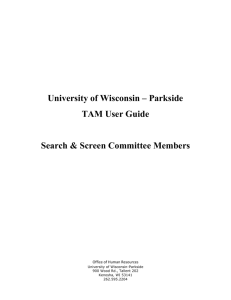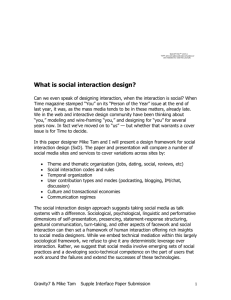here
advertisement
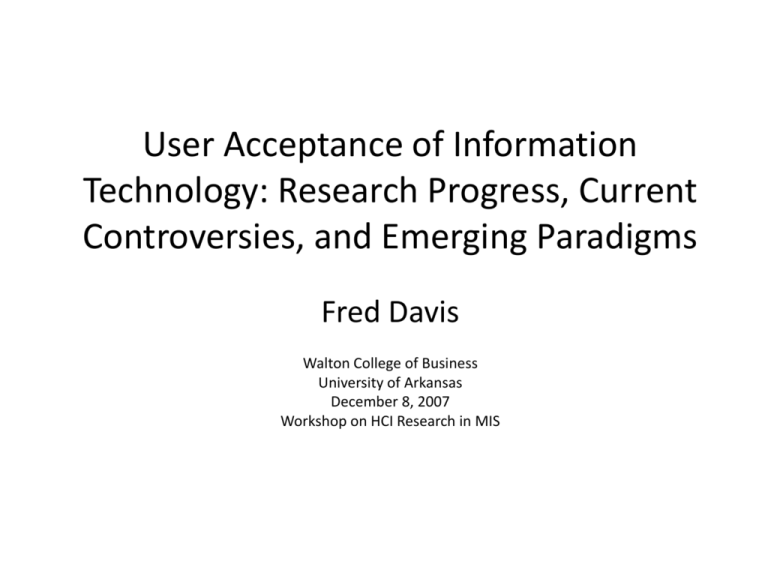
User Acceptance of Information Technology: Research Progress, Current Controversies, and Emerging Paradigms Fred Davis Walton College of Business University of Arkansas December 8, 2007 Workshop on HCI Research in MIS Outline • TAM overview and evolution • TAM metaanalyses • • • • • Paradigms and scientific progress Current TAM impasse Gaps and limitations in TAM++ research Promising directions for TAM research Cognitive Neuroscience and Neuro – IS TAM Overview • Problem Statement – High failure rate of IS implementations • 1980’s IS Implementation Research – Mixed and inconclusive • Keen 1980 “reference disciplines and cumulative tradition” • TAM – Theoretical foundations – Psychometrically validated measures • IT Design Characteristics – Functionality – User Interface Technology Acceptance Model (TAM) Perceived Usefulness External Variables e.g., Training System Chars. Behavioral Intention Perceived Ease of Use (Davis 1989--MISQ; Davis et al. 1989--Mgmt Science) Usage Behavior Summary of Key Findings from Early TAM Research • Perceived usefulness is key determinant of acceptance • Perceived ease of use is a secondary determinant (direct and indirect effect on BI) • TAM compares favorably with other models • TAM is robust across populations, settings, technologies TAM Evolution • 1990’s Proliferation • Consolidation • 1999 antecedents of EOU • 2000 antecedents of Usefulness • 2003 Unified Theory (UTAUT) • Metaanalyses (2003-2007) • Citations • 1989 MISQ cited 900+ times • 1989 Mgt Sci cited 750+ times • TAM in Workshop on HCI in MIS, ICIS Venkatesh 1999 ISR Determinants of EOU TAM Perceived Usefulness Behavioral Intention to Use Anchors Perceived Ease of Use Adjustments Experience Determinants of EOU Anchors Computer Self-Efficacy 3 Perceptions of External Control Perceived Usefulness 2 2 Behavioral Intention to Use Computer Anxiety Computer Playfulness Perceived Ease of Use 1 1 Perceived Enjoyment 1 Objective Usability Adjustments Notes: “1” indicates that experience moderated the relationship between the two constructs, as expected “2” indicates that experience moderated the relationship, though not expected “3” indicates that experience had a a direct effect on the construct, as expected Venkatesh & Davis 2000 Mgt Sci Determinants of Usefulness Social Influence Processes Technology Acceptance Model Experience Perceived Usefulness Intention to Use Cognitive Instrumental Processes Perceived Ease of Use Usage Behavior Social Influence Processes Experience Voluntariness of Use A Subjective Norm B C Perceived Usefulness Image Cognitive Instrumental Processes Perceived Ease of Use Experience Intention to Use Usage Behavior Cognitive Instrumental Processes Social Influence Processes Experience Perceived Usefulness Job Relevance Output Quality Results Demo. Perceived Ease of Use Experience Intention to Use Usage Behavior Venkatesh et al 2003 MISQ Unified Model Job Performance Expectancy Complexity Expectancy .46*** A .20** Social Influence Behaviora l Intention B .18* R2 = .41 .05 Attitude Toward .56*** Technology Usage R2 = .40 .08 A .19* Using Tech. Facilitating Conditions A: 2-way interaction, with experience as modera B: 3-way interaction, with experience and voluntariness as moderators Different Types of Technology • • • • • • Individual productivity tools Groupware Enterprise systems E-Commerce Workflow Mobile technology King & He 2006 I&M • Meta-analysis of 88 studies • “The results show TAM to be a valid and robust model that has been widely used, but which potentially has wider applicability.” • Moderators – User types – Usage types Jeyaraj, et al. 2006 JIT • Metaanalysis of 99 adoption studies – 48 individual level studies – 51 organizational level studies • Best individual adoption predictors – – – – – • Best organizational adoption predictions – – – – • • Perceived Usefulness Top Management Support Computer Experience User Support Behavioral Intention Top Management Support External Pressure Professionalism of IS unit External Information Sources Top Management Support was main linkage between individual and organizational IT adoption Identify 10 areas for further exploration Schepers & Wetzels 2007 I&M • • • • Metaanalysis of 63 TAM studies Focused on role of subjective norm Confirmed original TAM relationships Large effect sizes of SN – On usefulness (internalization) – On intention (compliance) Sun & Zhang 2006 IJHCS • Role of moderating factors in technology acceptance – Low explanatory power of TAM models (<60%) – Inconsistent relationships found • 69 studies reviewed • Ten moderating factors in three groups – Organizational factors (voluntariness, nature of task and profession) – Technology factors (complexity, purpose, individual vs. group) – Individual factors (gender, intellect, experience, age, culture) • Moderators increase explanatory power Sabherwal et al 2006 Mgt Sci • Individual and organizational determinants • Metaanalysis of 121 studies • Integrated, emergent model – – – – – – – Top mgmt support Facilitating conditions User experience, attitude, training, participation System Quality Perceived usefulness User satisfaction System use • Consistent with prior research on technology adoption and use Scientific Progress Every scientific truth goes through three states: first, people say it conflicts with the Bible; next, they say it has been discovered before lastly, they say they always believed it. Louis Agassiz Nature of Scientific Progress • Role of Paradigms (e.g., Kuhn 1962) • • • • Container (how much can it hold) Vehicle (how far can it go? How fast?) Advantage – enables research progress Disadvantage – constrains research progress • Theory can obstruct research progress • Selective filter, lens • Confirmation bias • Revolution vs. Evolution • Parsimony, Power, Generality TAM Research Impasse • JAIS Special Issue April 2007 – Lucas, Swanson, & Zmud “Implementation…” – Benbasat & Barki “Quo Vadis, TAM?” • Proliferation of ad hoc incremental extensions with no overarching conceptual structure • Successive studies that provide diminishing marginal contributions • IS researchers’ attention being overly restricted to minor extensions of TAM “Restlessness and discontent are the first necessities of progress. “ Thomas Edison Recommended Directions for TAM • Benbasat & Barki • • • • • Go back to TRA/TPB Better conceptualization of system usage Longitudinal, multi-stage models Impact of IT design characteristics Objective usefulness • Bagozzi • Goal self-regulation • Group, cultural, social aspects • Emotions Return to TRA/TPB? • Benbasat &Barki 2007 JAIS advocate this – Claim that UTAUT does this – Provides structure for expanding TAM • Pavlou & Fygenson 2006 MISQ – B2C top beliefs elicited • Usefulness, ease of use, trust – TPB omits direct influence of beliefs on BI • Bagozzi 2007 JAIS – TPB has many same limitations as TAM Usage Reconceptualizations • Beyond frequency & duration • Burton-Jones & Straub 2006 ISR • • • • User-System-Task Cognitive Absorption Deep structure usage (task-relevant feature use) Objective performance • Barki et al 2007 ISR • • • • Task-technology-individual Hierarchical goal-oriented actions Task-technology adaption Individual adaption Three Key Limitations of TAM++ Paradigm • Static, cross-sectional, snapshot-oriented – Individual level of analysis – Limited span across causal chain • Emphasis on controlled, conscious processing – Exclusion of automatic processing – Overlook multitasking • Limited account of social processes – Knowledge collaboration – Collective processes Longer span across causal chain: Wixom & Todd 2005 ISR • Theoretical Integration of User Satisfaction and Technology Acceptance • Bridge from design and implementation of system characteristics (a strength of the user satisfaction literature) to prediction of usage (a strength of the TAM literature) Venkatesh 2006 Dec Sci • Business process change; process standards • Business process characteristics • Interventions (e.g., simulation based training) • Supply-chain technologies • Multi-stakeholder technologies • Interventions to reduce goal incongruence and information assymetry • Services • Service quality, failure, recovery • Service design characteristics Major Theoretical Extensions of TAM • Principal-Agent Theory – Ba, et al. 2001 Mgt Sci; Bhattacherjee 1998 Dec Sci; Pavlou et al 2007 • Multi-level studies of adoption – Lapointe & Rivard 2005 MISQ, 2007 ISR; Frambach & Schillewaert 2002 J. Bus Res; Gopalakrishnan, et al. IEEE TEM • Longitudinal multi-stage modeling – Kim et al 2006 Mgt Sci Devaraj & Kohli 2005 Mgt Sci • Performance Impacts of Information Technology: Is Actual Usage the Missing Link? • “actual usage” may be a key variable in explaining the impact of technology on performance…omittion of this variable may be a missing ling in IT payoff analyses Automaticity and Multitasking • TAM++ models presume conscious processing – Conscious intentions and beliefs – Theory of Reasoned Action/Planned Behavior • Cognitive skill acquisition • Habit versus intention – Intention-behavior relationship weakens with habit – Habits toward previous behavior can undermine intentions to adopt new behavior Dual Processing and Economics • Daniel Kahneman 2002 – Two modes of cognitive processing • System 1 (intuition) – fast, automatic, effortless, associative, difficult to modify • System 2 (reasoning) – slower, serial, effortful, deliberately controlled, rule-governed, flexible • Vernon Smith 2002 – “human activity is diffused and dominated by unconscious, autonomic, neuropsychological systems that enable people to function effectively without calling upon the brain’s scarcest resource – attentional and reasoning circuitry” Automaticity in IS Research • Habit in IS Continuance • Mindfulness-Mindlessness Paradox – Butler & Gray 2006 MISQ • Routine-based reliability • Mindfulness-based reliability • Individual and collective mindfulness Dual-Task Interference • Primary task demands most attention • Secondary task can be performed with limited attention • Bottlenecks, working memory load • Task and tool as dual tasks • Electronic brainstorming – Heninger et al 2006 ISR Neuro-IS • Dimoka, Pavlou, & Davis 2007 ICIS – “The potential of cognitive neuroscience for IS Research” – Neural underpinnings of cognitive processes – Brain scanning (fMRI, etc.) – Many recent discoveries • • • • Decision making, risk, uncertainty Trust, cooperation, competition Goal self-regulation Automaticity and multitasking Major Areas of the Brain Motor Cortex DLPFC iPC ACC MPFC VM PFC PCC CN Visual Cortex IC NA OBF A Prefrontal Cortex H Cerebellum Limbic System Other key areas Brain Stem DLPFC: Dorsolateral Prefrontal Cortex, VMPFC: Ventromedial Prefrontal Cortex, OBF: Orbitofrontal Cortex MPFC: Medial Prefrontal Cortex, ACC/PCC: Anterior/ Posterior Cingulate Cortex, NA: Nucleus Accumbens; A: Amygdala, H: Hippocampus, CN: Caudate Nucleus, IC: Insular Cortex, iPC: Inferior Parietal Cortex Brain Areas Activated for Focal Processes Brain Area Process Decision Making Dorsolateral Prefrontal Cortex Ventromedial Prefrontal Cortex X Orbitofrontal Cortex Medial Prefrontal Cortex X Limbic System Amygdala Anterior Cingulate Cortex X X X Risk Caudate Nucleus X Inferior Parietal Cortices X X X X Loss X X Rewards Consumer Behavior Insular Cortex X Uncertainty Ambiguity Nucleus Accumbens X X X X X X X X X Theory of Mind X X Trust X Distrust Cooperation Competition X X X X X Neuro-IS and TAM++ Research • Neural correlates of perceived usefulness and ease of use • Social influence processes and “theory of mind” • Automaticity and habit • Goal Self-regulation • Emotional processes Genetic Epistemology and Piaget’s Philosophy of Science • Piaget (vs. Kuhn) on Scientific Progress – J.Y. Tsou 2006 Theory and Research • Continuity vs. discontinuity • Series of successive approximations to truth • Equilibration – Assimilation and accommodation of existing knowledge structures (reorganization) • Progress as integrative, cumulative process Summary • Reaching the limits of TAM++ paradigm – Need to identify and remove limitations of TAM++ paradigm • Emphasize impact of IT design characteristics • Integrate across levels of analysis – From static to dynamic analyses of complex adoption processes • Neuro-IS • Build upon and go beyond accumulated knowledge “However much our knowledge of human behavior falls short of our need for such knowledge, still it is enormous” Herbert Simon 1978
